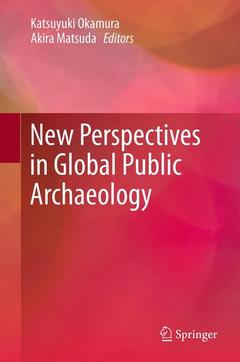Description
New Perspectives in Global Public Archaeology, 2012
Coordinators: Okamura Katsuyuki, Matsuda Akira
Language: English
Subjects for New Perspectives in Global Public Archaeology:
Keywords
Archaeological Theory; Canadian archaeology; Chinnese archaeology; Cultural Heritage Management; Japanese cultural heritage; Jordanian archaeology; South Korean material culture; archaeology and the broader community; archaeology of slavery; educational purpose of archaeology; ethics of modern day archaeology; socio-political aspects of archaeology
Publication date: 12-2012
280 p. · 15.5x23.5 cm · Paperback
Publication date: 09-2011
280 p. · 15.5x23.5 cm · Paperback
Description
/li>Contents
/li>Comment
/li>
Since its very beginning, archaeology has in many senses always related to a much wider constituency than just archaeologists. This relationship between archaeology and the public has often been overlooked and constantly changes. Public archaeology, as a field of research and practice, has been developing since the 1970s in English-speaking countries, particularly in the United States, Britain, and Australia, and is today beginning to spread to other parts of the world. Global expansion of public archaeology comes with the recognition of the need for a careful understanding of local contexts, particularly the culture and socio-political climate.
This volume critically examines the current theories and practices of public archaeology through relevant case studies from different regions throughout the world, including: Japan, China, South Korea, New Caledonia, South Africa, Senegal, Jordon, Italy, Peru, Canada, the United Kingdom, the United States, and Australia. These case studies are examined from a wide variety of theoretical contexts, to provide a thorough and comprehensive guide to the state of public archaeology today, as well as implications for its future.
As the theory and practice of public archaeology continues to change and grow, archaeology?s relationship with the broader community needs to be critically and openly examined. The contributions in this wide-ranging work are a key source of information for anyone practicing or studying archaeology in a public context.
Introduction: new perspectives in global public archaeology.-Is a shared past possible? The ethics and practice of archaeology in the 21st century.- Engaged archaeology: whose community? Which public?.- “Public archaeology” in China: a preliminary investigation.-Public archaeology in Canada.- From object-centered to people-focused: exploring an invisible "gulf" between archaeologists and the public in contemporary Japan.- Public archaeology in Korea: a duet of popularity and nationalism.- Public archaeology in Thailand.- Archaeology in a multicultural and multi-ethnic nation under construction: the case of New Caledonia.- Digging on contested grounds: archaeology and the commemoration of slavery on Gorée Island, Senegal.-The heritage uncertainty principle: excavating air raid shelters from the second world war.- Archaeology dreaming: post-apartheid urban imaginaries and the remains of the Prestwich Street dead.-Archaeology by the (Far) East in the West: what do local people think if Japanese archaeologists excavate the "Villa of Augustus" in Italy?.- Meaning-making process of cultural heritage in Jordan: the local communities, the contexts and the archaeological sites in the Citadel of Amman.- The excluded past in Jordanian formal primary education: the introduction of archaeology.- Archaeological education and reasons why: a personal view from the United Kingdom.- The role of archaeology and its challenges in Japanese school education: the curriculum and history textbooks.- Multivocality in multimedia: collaborative archaeology and the potential of cyberspace.- Looking for an identity: archaeologists, local communities, and public archaeology in Peru.- Sharing the pleasure of excavation: the public archaeology program at the Miharashidai site, Japan.-
Essential guide to Public Archaeology that covers the field both geographically and theoretically
Contributions from international experts, providing case studies from all over the world
Critically examines the development of public archaeology
Includes supplementary material: sn.pub/extras
These books may interest you

Sculpture and Archaeology 93.25 €



